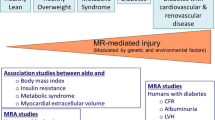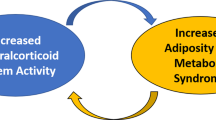Abstract
The many similarities between the metabolic syndrome and Cushing’s syndrome led to the hypothesis that excess glucocorticoids (GC) are part of the pathogenesis linking their features. We review recent work that confirms the initial similarities (obesity, glucose intolerance, hypertension, and hyperlipidemia) and extends them to associated features of both syndromes (osteopenia, hypogonadism, leukocytosis, depression, and muscle weakness). Recent studies report that these features also occur in subclinical Cushing’s syndrome, hypercortisolemic depression, and the transgenic overexpression of 11β-hydoxysteroid dehydrogenase type 1 (11β-HSD1) in mouse models of excess GC in adipose tissue. Reducing excess GC—in the clinical syndromes and in the mouse model—reverses many of these features. Because local tissue excess GC may have a central role in the pathogenesis of the metabolic syndrome, selective 11β-HSD1 inhibitors are under active development by several pharmaceutical companies.
Similar content being viewed by others
References and Recommended Reading
Eckel RH, Grundy SM, Zimmet PZ: The metabolic syndrome. Lancet 2005, 365:1415–1428.
Bjorntorp P, Holm G, Rosmond R: Hypothalamic arousal, insulin resistance and type 2 diabetes mellitus. Diabetic Medicine 1999, 16:373–383.
Walker BR: Cortisol: cause and cure for metabolic syndrome? Diabet Medicine 2006, 23:1281–1288.
Alberti KG, Zimmet P, Shaw J: The metabolic syndrome: a new world definition. Lancet 2005, 366:1059–1062.
Newell-Price J, Bertagne X, Grossman AB, et al.: Cushing’s syndrome. Lancet 2006, 367:1605–1617.
Weber-Hamann B, Werner M, Hentschel F, et al.: Metabolic changes in elderly patients with major depression: evidence for increased accumulation of visceral fat at follow-up. Psychoneuroendocrinol 2006, 31:347–354.
Kahl KG, Bester M, Greggersen W, et al.: Visceral fat deposition and insulin sensitivity in depressed women with and without co morbid borderline personality disorder. Psychosomatic Med 2005, 67:407–412.
Vogelzangs N, Suthers K, Ferrucci L, et al.: Hypercortisolemic depression is associated with the metabolic syndrome in late life. Psychoneuroendocrinol 2007, 32:151–159.
Rockall AG, Sohaib SA, Evan D et al.: Computed tomography assessment of fat distribution in male and female patients with Cushing’s syndrome. Eur J Endocrin 2003, 149:561–567.
Faggiano A, Pivonello R, Spiezia S, et al.: Cardiovascular risk factors and common carotid artery caliber and stiffness in patients with Cushing’s disease during active disease and 1 year after disease remission. J Clin Endo Metab 2003, 88:2527–2533.
Mancini T, Kola B, Mantero F: High cardiovascular risk in patients with Cushing’s syndrome according to 1999 WHO/ISH guidelines. Clin Endocrinol 2004, 61:768–777.
Tauchmanova L, Rossi R, Biondi B, et al.: Patients with subclinical Cushing’s syndrome due to adrenal adenoma have increased cardiovascular risk. J Clin Endocrinol Metab 2002, 87:4872–4878.
Terzolo M, Pia A, Ali A, et al.: Adrenal incidentaloma: a new cause of the metabolic syndrome? J Clin Endocrinol Metab 2002, 87:988–1003.
Rossi R, Tauchmanova L, Luciano A, et al.: Subclinical Cushing’s syndrome with adrenal incidentaloma: clinical and biochemical features. J Clin Endocrinol Metab 2000, 85:1440–1448.
Erbil Y, Ademoglu E, Ozbey N, et al.: Evaluation of the cardiovascular risk in patients with subclinical Cushing’s syndrome before and after surgery. World J Surg 2006, 30:1665–1171.
Weber-Hamann B, Hentschel F, Kniest A, et al.: Hypercortisolemic depression is associated with increased intra-abdominal fat. Psychosomatic Med 2002, 64:274–277.
Wiehe M, Fuchs SC, Moreira LB, et al.: Absence of association between depression and hypertension: results of a prospectively designed population-based study. J Hum Hypertens 2006, 20:434–439.
Zhao LJ, Liu YJ, Liu PY, et al.: Relationship of obesity with osteoporosis. J Clin Endocrinol Metab 2007, 92:1640–1646.
Von Muhlen D, Safii S, Jassal SK, et al.: Associations between the metabolic syndrome and bone health in older men and women: the Rancho Bernardo Study. Osteoporosis Int 2007, Osteoporosis Int 2007, Epub ahead of print.
Kristo C, Jemtland R, Ueland T, et al.: Treatment of endogenous Cushing’s syndrome: a prospective, long term study. Eur J Endocrinol 2006, 154:109–118.
Chiodini I, Guglielmi G, Battista C, et al.: Spinal volumetric bone mineral density and vertebral fractures in female patients with adrenal incidentaloma: the effect of subclinical hypercortisolism and gonadal status. J Clin Endocrinol Metab 2004, 89:2237–2241.
Altindag O, Altindag A, Asoglu M, et al.: Relation of cortisol levels and bone mineral density among premenopausal women with major depression. Int J Clin Pract 2007, 61:416–420.
Gold DT, Solimeo S: Osteoporosis and depression: a historical perspective. Curr Osteoporo Rep 2006, 4:134–139.
Laaksonen DE, Niskanen L, Punnonen K, et al.: Testosterone and sex hormone-binding globulin predict the metabolic syndrome and diabetes in middle-aged men. Diabetes Care 2004, 27:1036–1041.
Laaksonen DE, Niskanen L, Punnonen K, et al.: The metabolic syndrome and smoking in relation to hypogonadism in middle-aged men: a prospective cohort study. J Clin Endocrinol Metab 2005, 90:712–719.
Muller M, Grobbee DE, Den Tonkelarri I, et al.: Endogenous sex hormones and metabolic syndrome in aging men. J Clin Endocrinol Metab 2005, 90:2618–2623.
Corona G, Mannucci E, Petrone L, et al.: A comparison of NCEP-ATPIII and the IDF metabolic syndrome definitions with relation to metabolic syndrome associated sexual dysfunction. J Sex Med 2007, 3:789–796.
Kapoor D, Goodwin E, Channer KS, et al.: Testosterone replacement therapy improves insulin resistance, glycaemic control, visceral adiposity and hypercholesterolemia in hypogonadal men with type 2 diabetes. Eur J Endocrinol 2006, 154:899–906.
Lin KC, Tsai ST, Kuo SC, et al.: Interrelationship between insulin resistance and menopause on the metabolic syndrome and its individual components among nondiabetic women in the kimen study. Am J Med Sci 2007, 333:208–214.
Salpeter SR, Walsh JM, Ormiston TM, et al.: Meta-analysis: effect of hormone replacement therapy on components of the metabolic syndrome in postmenopausal women. Diabetes Obes Metab 2006, 8:538–554.
Thomson SP, Gibbons RJ, Smars PA, et al.: Incremental value of the leukocyte differential and the rapid creatine kinase-MB isoenzyme for the early diagnosis of myocardial infarction. Ann Intern Med 1995, 122:335–341.
Desai MY, Daiai D, Santos RD, et al.: Association of body mass index, metabolic syndrome and leukocyte count. Am J Cardiol 2006, 97:835–838.
Shim WS, Kim HF, Kang ES, et al.: The association of total and differential white blood cell count with metabolic syndrome in type 2 diabetic patients. Diabetes Res Clin Pract 2006, 73:284–291.
Wang YY, Lin SY, Liu PH, et al.: Association between hematological parameters and metabolic syndrome components in a Chinese population. J Diabetes Complications 2004, 18:322–327.
Tsai JJC, Sheu SH, Chiu HC, et al.: Association of peripheral total and differential leukocyte count with metabolic syndrome and risk of ischemic cardiovascular diseases in patients with type 2 DM. Diabetes Metab Res Rev 2007, 23:111–118.
Kinder LS, Carnethon MR, Palaniappan LP, et al.: Depression and the metabolic syndrome in young adults: findings from the third National Health and Nutrition Examination Survey. Psychosom Med 2004, 66:316–322.
Wijndaele K, Duvigneaud N, Matton L, et al.: Muscular strength, aerobic fitness, and metabolic syndrome risk in Flemish adults. Med Sci Sports Exerc 2007, 39:233–240.
Jurca R, Lamonte MJ, Barlow CE, et al.: Association of muscular strength with incidence of metabolic syndrome in men. Med Sci Sports Exerc 2005, 37:1849–1855.
Miyatake N, Wada J, Saito T, et al.: Comparison of muscle strength between Japanese men with and without metabolic syndrome. Acta Med Okayama 2007, 61:99–102.
Lamonte MJ, Barlow CE, Jurca R, et al.: Cardiorespiratory fitness is inversely associated with the incidence of metabolic syndrome: a prospective study of men and women. Circulation 2005, 112:505–512.
Broadley AJM, Korszun A, Abdelaal E, et al.: Inhibition of cortisol production with metyrapone prevents mental stress-induced endothelial dysfunction and baroreflex impairment. J Am Coll Cardiol 2005, 46:344–350.
Broadley AJM, Korszun A, Abdelaal E, et al.: Metyrapone improves endothelial dysfunction in patients with treated depression. J Am Coll Cardiol 2006, 48:170–175.
Witte DR, Westerink J, De Koning EJ, et al.: Is the association between flow-mediated dilation and cardiovascular risk limited to low-risk populations? J Am Coll Cardiol 2005, 45:1987–1993.
Yeboah J, Crouse JR, Hsu FC, et al.: Brachial flow-mediated dilation predicts incident cardiovascular events in older adults: the Cardiovascular Health Study. Circulation 2007, 115:2390–2397.
Reynolds RM, Walker BR: Can cortisol predict the future in obesity? Clin Endocrinol 2007, 67:1–2.
Wang M: The role of glucocorticoid action in the pathophysiology of the metabolic syndrome. Nutr Metab 2005, 2:3–16.
Darmon P, Dadoun F, Boullu-Ciocca S, et al.: Insulin resistance induced by hydrocortisone is increased in patients with abdominal obesity. Am J Physiol Endocrinol Metab 2006, 291:E995–E1002.
Epel ES, McEwen B, Seeman T, et al.: Stress and body shape: stress-induced cortisol secretion is consistently greater among women with central fat. Psychosom Med 2000, 62:623–632.
Milagro FI, Campion J, Marinez JA: 11-beta hydroxysteroid dehydrogenase type 2 expression in white adipose tissue is strongly correlated with adiposity. J Steroid Biochem Mol Biol 2007, 104:81–84.
Gambineri A, Vicennati V, Genghini S, et al.: Genetic variation in 11β-hydroxysteroid dehydrogenase type 1 predicts adrenal hyperandrogenism among lean women with polycystic ovary syndrome. J Clin Endocrinol Metab 2006, 91:2295–2302.
Fallo F, Federspil G, Vegglio F, et al.: The metabolic syndrome in primary aldosteronism. Curr Hypertens Rep 2007, 9:106–111.
Kidambi S, Kotchen JM, Grim CE, et al.: Association of adrenal steroids with hypertension and the metabolic syndrome in blacks. Hypertension 2007, 49:704–711.
Bochud M, Nussberger J, Bovet P, et al.: Plasma aldosterone is independently associated with the metabolic syndrome. Hypertension 2006, 48:239–245.
Engeli S, Bohnke J, Gorzelniak K, et al.: Weight loss and the renin-angiotensin-aldosterone system. Hypertension 2005, 45:356–362.
Fallo F, Veglio F, Bertello C, et al.: Prevalence and characteristics of the metabolic syndrome in primary aldosteronism. J Clin Endocrinology Metab 2006, 91:454–459.
Catena C, Lapenna R, Baroselli S, et al.: Insulin sensitivity in patients with primary aldosteronism: a follow-up study. J Clin Endocrinol Metab 2006, 91:3457–3463.
Giacchetti G, Ronconi V, Turchi R et al.: Aldosterone as a key mediator of the cardiometabolic syndrome in primary aldosteronism: an observational study. J Hypertens 2007, 25:177–186.
Colussi G, Catena C, Lapenna R, et al.: Insulin resistance and hyperinsulinemia are related to plasma aldosterone levels in hypertensive patients. Diabetes Care 2007, 30:2349–2354.
Author information
Authors and Affiliations
Corresponding author
Rights and permissions
About this article
Cite this article
Thomson, S.P., Stump, C.S., Romayne Kurukulasuriya, L. et al. Adrenal steroids and the metabolic syndrome. Current Science Inc 9, 512–519 (2007). https://doi.org/10.1007/s11906-007-0093-4
Published:
Issue Date:
DOI: https://doi.org/10.1007/s11906-007-0093-4




